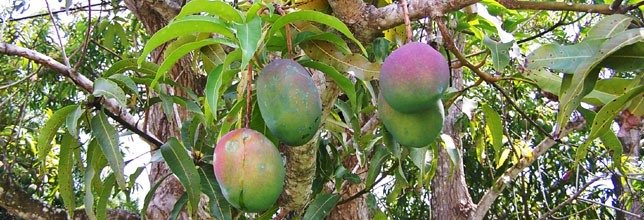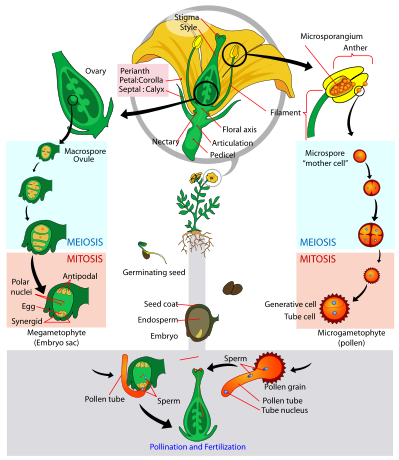
The Birds and the "Bees" of Mangos...
As a member of the Angiosperms, the mango exhibits some unique characteristics in regards to reproduction. Here is a summary of the process each plant must undergo to produce offspring!A mango tree must first be able to be pollinated, therefore it needs to bear flowers. Typically, mango trees are pollinated via wind, flies, butterflies, and moths. A unique characteristic of this organism is that mango trees are rarely pollinated by bees, such as
 the
European Honey Bee. This is believed to be the case as
many other plants are also producing flowers at the same time mango
trees do and the
bees are more attracted to other plants. Mango plants can also self
pollinate as they are monoecious, meaning male and female
reproductive organs are found on the same plant. These
reproductive organs are found in the flowers of the plant.
Depending on the region, a single mango plant varies in the
composition of male to hermaphroditic flowers as well as month of
flower production. Most mango varieties produce 25% male
flowers and the remaining 75% are hermaphroditic. Depending on
the region, plants can flower anywhere from December to March.
the
European Honey Bee. This is believed to be the case as
many other plants are also producing flowers at the same time mango
trees do and the
bees are more attracted to other plants. Mango plants can also self
pollinate as they are monoecious, meaning male and female
reproductive organs are found on the same plant. These
reproductive organs are found in the flowers of the plant.
Depending on the region, a single mango plant varies in the
composition of male to hermaphroditic flowers as well as month of
flower production. Most mango varieties produce 25% male
flowers and the remaining 75% are hermaphroditic. Depending on
the region, plants can flower anywhere from December to March.

Once pollinated, a fruit can begin to develop on the plant. Mangos produce drupe-like fruit, meaning a single seed is encased in a leathery coating. The fruit produced varies greatly with the different locations and cultivars of mangos. The skin can range from a yellow-green color to a red and the flesh can taste sweet to acidic and fibrous. Within approximately 150 days after pollination, the mango fruit is formed as a protection around the all important seed.
To continue this process, some means of seed dispersal must take place. Often, animals will ingest the fruit for nutrition and later expel the seed. If the seed is lucky (conditions for seed growth are met) the seed may germinate in 2-4 weeks and produce a new mango tree! Within 3-6 years, the tree will be able to bear fruit. Trees that are younger than 10 years can produce fruit yearly. After this benchmark, mango trees typically produce fruit biannually.

All angiosperms, including the mango, display an alternation of generations. This process includes a multicellular haploid and diploid phase, unlike animals which possess only a multicellular diploid phase. In addition, all angiosperms also exhibit double fertilization. This process is much more complex than the fertilization seen in most other plants and provides immediate nutrition for the developing egg. Above is a generalized version of the lifecycle of an angiosperm. Be sure to recognize that both the haploid and diploid stages are multicellular.
Besides the insects involved in pollination, many other organisms closely react with the mango. Check out these interactions or return home!